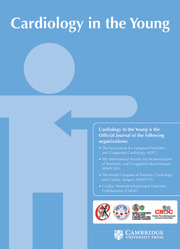No CrossRef data available.
Article contents
Closure of perimembranous ventricular septal defects using the Amplatzer vascular plug II: experience of a Mexican centre
Published online by Cambridge University Press: 24 February 2025
Abstract
To demonstrate safety and efficacy of using the AmplatzerTM vascular plug II device for perimembranous ventricular septal defect closure with retrograde approach and show the follow-up in all patients.
At present, there is no FDA-approved device for transcatheter closure of perimembranous ventricular septal defects. Small studies and case reports have shown the use of various catheter-based devices in an off-label management; however, there are no large studies to show their efficacy. The second generation of AmplatzerTM vascular plug seems to offer a safe and attractive alternative for this procedure. Besides, a retrograde approach might decrease procedure time and radiation exposure time.
Patients with congenital perimembranous ventricular septal defects who underwent transcatheter closure using Amplatzer vascular plug II devices were included. Primary end point was to determine efficacy and safety of this generation of devices and the incidence of complications at follow-up (complete heart block and aortic/tricuspid/mitral regurgitation). Forty-five patients underwent perimembranous ventricular septal defect closure at a median age of 6 years (9 months–17 years). During the catheterization, there were only minor complications and at follow-up of 48 ± 25.7 months (up to 96 months). Closure rate was high of 93.3% and freedom from atrioventricular block was 100%.
The second generation of the AmplatzerTM vascular plug II seems to offer a safe and attractive alternative for percutaneous closure of the perimembranous ventricular septal defects.
- Type
- Original Article
- Information
- Copyright
- © The Author(s), 2025. Published by Cambridge University Press



